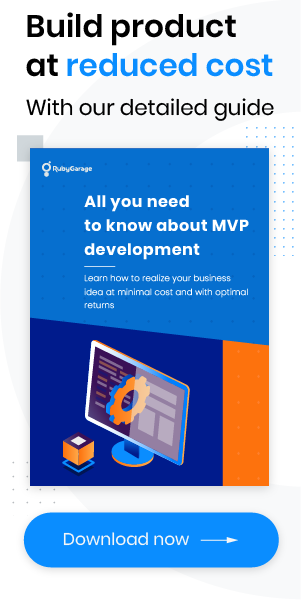-
Product Management
Software Testing
Technology Consulting
-
Multi-Vendor Marketplace
Online StoreCreate an online store with unique design and features at minimal cost using our MarketAge solutionCustom MarketplaceGet a unique, scalable, and cost-effective online marketplace with minimum time to marketTelemedicine SoftwareGet a cost-efficient, HIPAA-compliant telemedicine solution tailored to your facility's requirementsChat AppGet a customizable chat solution to connect users across multiple apps and platformsCustom Booking SystemImprove your business operations and expand to new markets with our appointment booking solutionVideo ConferencingAdjust our video conferencing solution for your business needsFor EnterpriseScale, automate, and improve business processes in your enterprise with our custom software solutionsFor StartupsTurn your startup ideas into viable, value-driven, and commercially successful software solutions -
-
- Case Studies
- Blog
8 Emerging Ecommerce Trends that Will Shape Industry in 2018
What’s in store for ecommerce in 2018? Artificial intelligence, virtual reality, voice assistants, drones, and that’s not the end of the list. In this article, you’ll see data representing shopping preferences and habits. You’ll find eight major trends in the ecommerce sphere that will give you an insight on how to strengthen relations with your customers, build brand awareness, and more. Here they are.
#1. Meaningful customer experience as the next competitive battleground
Are you thinking of how to outperform your competitors in the ecommerce market? You definitely need to reconsider the experience your customers receive from you. A great customer experience (CX) is becoming a decisive factor for whether customers will buy from you and become enthusiastic advocates for your brand. Thus, 84 percent of companies in the USA are working to improve CX. And that’s not the limit.
Being customer-centric is more than just offering good service. Customer experience encompasses every interaction between a customer and a company throughout the business: whether that’s a customer viewing your ad on the internet, purchasing something, leaving a complaint, or reading a post on your blog.
A good CX exceeds customers’ expectations, meaning you guarantee your customers fast shipping, transparent pricing, an easy-to-navigate site, and exceptional customer service.
Why should you focus on providing a satisfying experience? Companies providing well-crafted experience can increase revenue, lower service costs, decrease customer churn, enhance customer loyalty, and get customer referrals.

#2. Data-driven personalization as an effective recommendation tool
Personalization is an essential part of satisfying customer experience. Customers don’t want to get generic service anymore. Instead, they want services targeted to their special needs. Customers are tired of pop-ups of items they just bought. They want marketers who understand their needs and satisfy them.
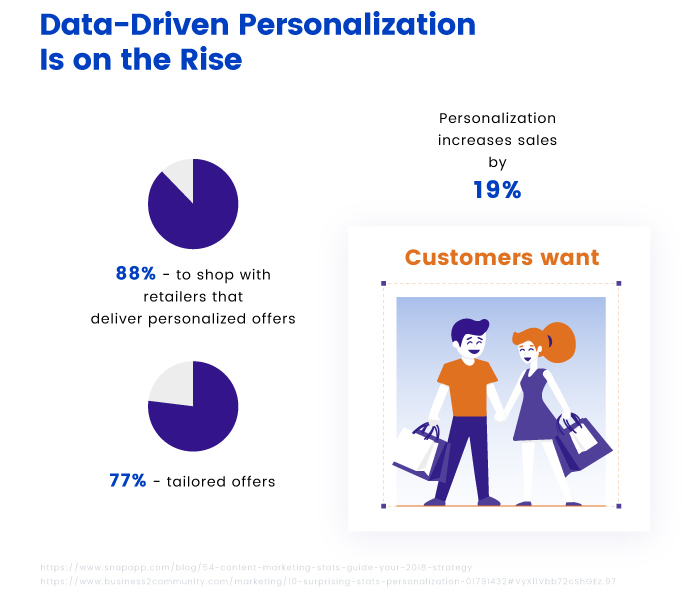
Many companies are competing on this ground, trying to provide unique solutions to their customers. Wonderbly, a company specialized in publishing personalized children’s book, offers to create an exclusive book for children of any age. Wonderbly’s team can add an actual satellite image of your child’s neighborhood into the story, make the the book’s protagonist look like your child, create a funny monster inspired by your child’s name, or show your child’s name in the form of a star constellation.
Using AI to personalize a customer’s journey is becoming a growing trend. This is technology that enables ecommerce websites to recommend products uniquely suited to shoppers. Smart personalization engines help marketers recognize customer intent and base product recommendation upon:
- A customer’s search terms
- A customer’s past purchases
- The current contents of a customer’s cart or wishlist
- Product rating, shares, and likes
- Customer’s local climate or other regional considerations
- Purchase histories of customers with similar demographics
Look at Walmart’s Easy Reorder. Easy Reorder integrates both in-store and online purchases to build a list of goods a customer buys most frequently (the system even knows the brands and sizes) so that a customer can view and repurchase these items with one click.
Marketers also use AI to provide more relevant product search results and immediate and useful customer service. Altitude Sports upgraded its search bar and thus generated twice as much revenue as it previously did.
#3. Multi-channel sales as an effective selling strategy
The explosive ecommerce growth created new sales channels. Now merchants have more options to contact their existing and potential customers; they can market their products on social media, marketplaces, and other mediums. This helps marketers re-engineer their businesses around customer experience.
Multiple sales channels help you expand your brand’s recognition, keep up with online shopping trends, increase your sales rates resulting in a higher ROI, and much more.

If you’re looking for a new channel to sell your goods, you can either consider a marketplace, a comparison shopping site, or a social network.
Marketplaces
Whereas сustomers may be skeptical of your newborn site, they already trust familiar market leaders like eBay, Amazon, Etsy, and Rakuten.com. This is why marketplaces are great platforms to place your product line. What’s more, almost half of online shoppers start researching goods on marketplaces. So it’s no surprise that 90 percent of independent online retailers in the U.S. are now selling through marketplaces.
Comparison shopping websites
Сomparison shopping websites, also known as price comparison websites or comparison shopping engines (CSEs) are channels for collecting product information from participating retailers, such as prices, features, reviews, and shipping options. Customers use this search engine to compare products from multiple retailers on a single page and choose the merchant which offers the best proposal. Comparison shopping websites can sell products directly or drive traffic to ecommerce product page sites. There are over 100 CSEs. The most popular ones are Google Shopping, NexTag, PriceGrabber, Shopping.com, and Shopzilla.
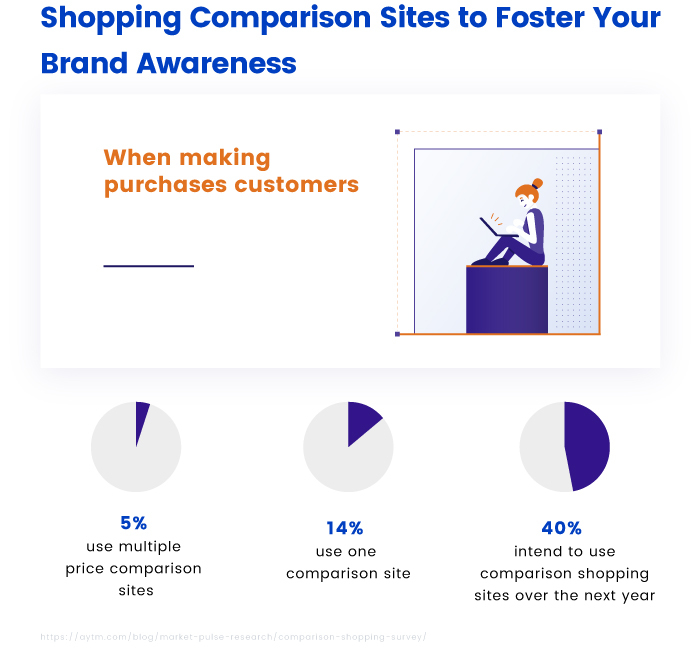
Social media
Since the “buy button” was introduced on social networking sites, social sites became not only places to advertise products but also places to convert visitors into buyers. Thus, the Facebook Shop lets businesses place buy buttons on their Facebook home pages. With Pinterest, users can spot Buyable Pins in search results, in related Pins, and on their business profiles.
Instagram and Shopify launched a “Shopping on Instagram” feature available to thousands of merchants. This feature allows merchants to tag Instagram photos with items for sale. When a customer clicks on a photo, they see detailed information about a product (a specific product’s price, description, and additional photos) along with a “Shop Now” button that leads to a quick checkout.
This way customers can make purchases without even leaving the social network.
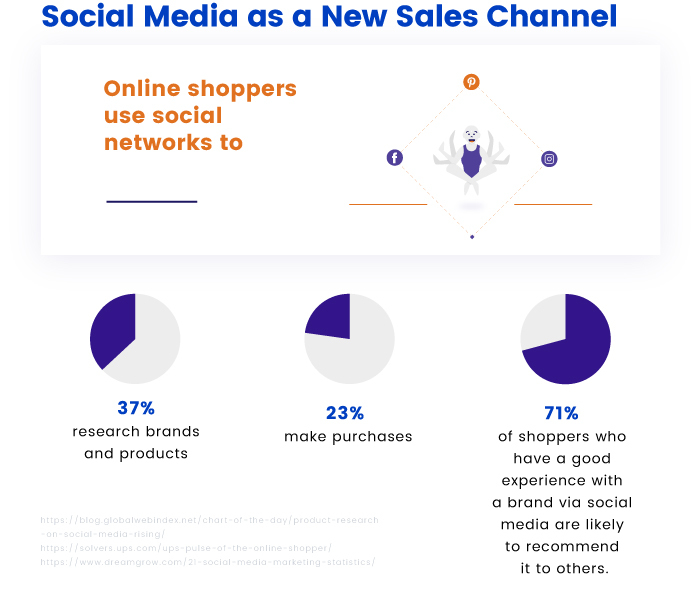
#4. Social influencers as good sales drivers
There are a large number of influencer campaigns which can tackle every part of your sales funnel. The right influencer marketing strategy can both educate consumers about your brand and engage new customers. In fact, influencer campaigns are 10 times more effective in online customer acquisition than affiliate campaigns.
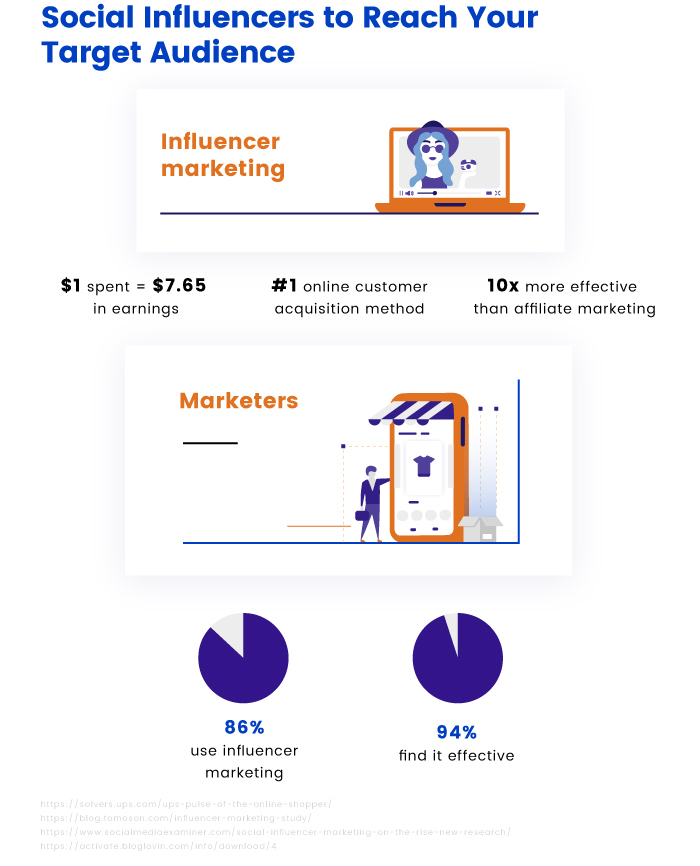
Based on your business goals, you can try to work with influencers on different platforms:
- If you need to build awareness around real-time events such as product launches or targetting young audiences, сooperate with Snapchat influencers.
- If you run a site with particularly visual products or want to gather lots of followers on social media, hire Instagram influencers. Instagram influencer campaigns are especially effective when paired with Instagram ads.
- If you’re working on engaging broader conversations online, collaborate with Twitter influencers.
- If you need both visual branding opportunities and rapid traffic to your site, employ YouTube influencers.
Many companies have already benefited from influencer marketing strategies. Daniel Wellington, a Swedish watch company, built up its brand by using Instagram influencers for natural product placements; influencers posted images associating their watches with aspirational lifestyles and offered discount promo codes along with their advertisements.
#5. Mobile commerce as the next frontier for shopping
Mobile ecommerce is one of the most prominent online purchasing trends. A mobile app can provide faster access to your brand compared to websites, since applications partially store their data on mobile devices and advance 24/7 support between your store and your customers.
Mobile apps simplify checkout processes, allowing users to complete purchases with one click and thus increase sales rates and lower cart abandonment rates. Additionally, an app can be a powerful marketing tool. You can leverage push notifications to inform customers about sales and special offers, or about items which have come back in stock. What’s more, a mobile app lets you arrange reward systems and re-engagement campaigns, resulting in loyal brand advocates.
The icing on the cake is the exclusive content you can entice your customers with like limited offers or special prices available only through your mobile app. Such content gives your regular customers reasons to download your app which means a higher conversion rate.
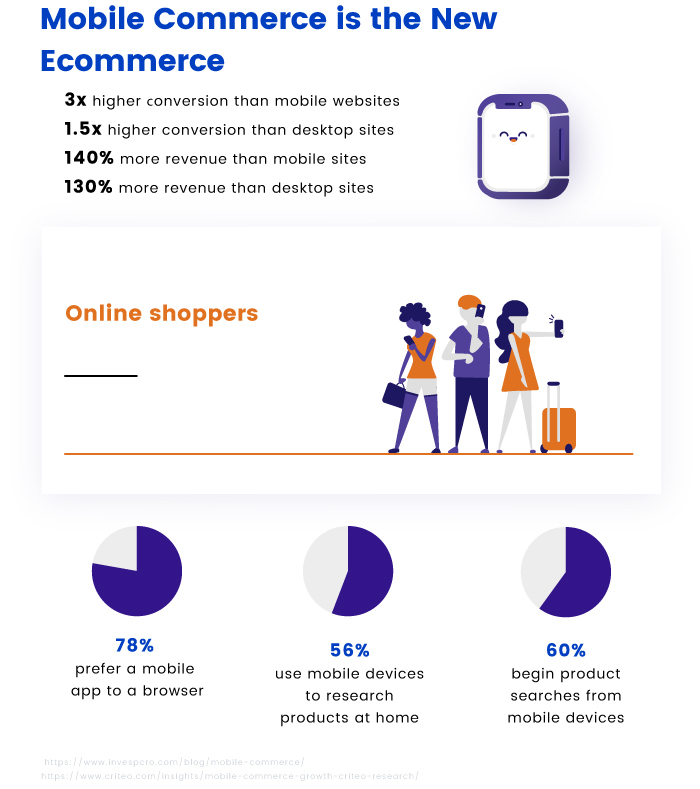
#6. Virtual commerce: providing the immersive experience
Augmented (AR) and virtual reality (VR) provides life-like shopping experiences and assists shoppers in finding the right products or services. Sometimes images and videos aren’t enough to provide a full picture of a product. Virtual reality helps visualize products. Now you can virtually try whatever you want ‒ clothes, footwear, cosmetics ‒ before actually buying them.
Fashion and cosmetics retail spheres are full of so-called “magic mirrors” apps which lets customer preview how certain garments or a particular shade of lipstick would look like on them. NARS makeup is using Facebook’s 360 Video to offer customers interactive 3D makeup tutorials. Strata’s Nu Skin’s Lumi Spa app lets customers use a facial massager via AR to see how the product works.
Cosmetics businesses, however, are not the only one using the benefits of AR and VR technologies. eBay and Myers have created a virtual store using AR technology. They supplied customers with iOS and Android apps to download and gave away 20,000 Google Cardboard headsets. Within their virtual store, users can access top products including electronics and women’s apparel, explore them, choose the ones they like, or reject the items they’ve previously chosen.
Virtual trials prevent customers from buying the wrong items and make customers feel comfortable about a purchase. From merchant’s perspectives, virtual trials stimulate conversion and lower return rate. And, obviously, merchants need to send fewer demo products and samples.

By using augmented and virtual reality technologies, retailers can create shopping processes which are both frictionless and fulfilling. They allow the retail industry to add an emotional component to any product through gaming, storytelling, and branded experiences. This way, companies engage customers and provide a piece of entertainment for social sharing.
#7. Voice-commerce as a new trend for online searches
Voice-activated assistants offer customers easy, freely accessible, and quick search mechanisms. Customers don’t need to type queries on small sized gadgets anymore; they can just ask their Alexa to find a new matte lipstick from NYX.
How does it work? When a customer makes a voice purchase request, Alexa tells them the item name and price and then asks the customer to confirm or cancel the order. Customers can also ask Alexa to track their shipped order or cancel the order they’ve just made.
The integration with newly created apps and other smart devices helps voice assistants better understand people’s requests and become more conversational. This integration makes searches more accurate and brings customers directly to their intended destinations.
Voice-commerce is one of the fastest growing trends in online shopping. Experts from the Consumer Technology Association say that smart speakers sales will double to $3.8 billion in 2018.
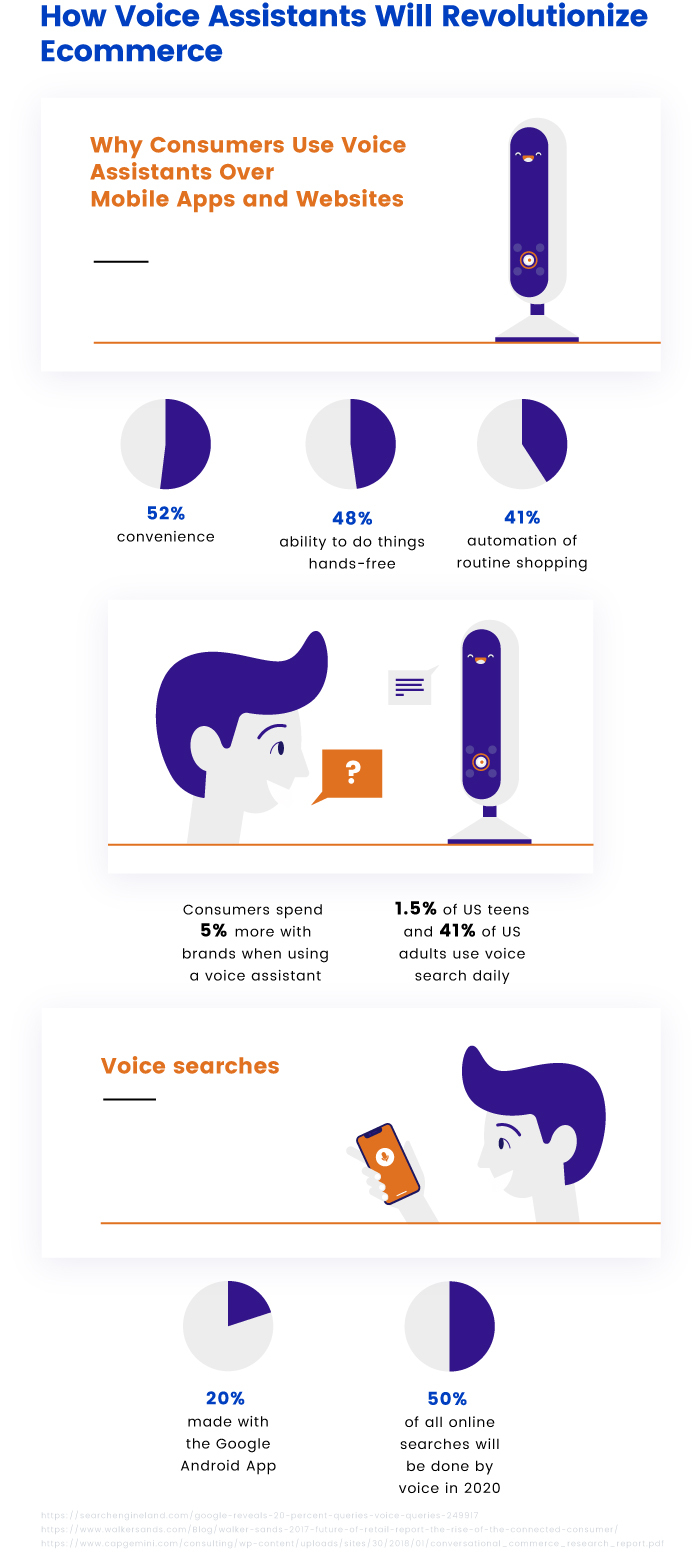
Voice technology has a promising future and opens a whole new variety of opportunities. Merchants are able to use voice assistants:
- To upgrade their live chat and create an AI concierge that shows product features, answers questions, and replies to customers’ concerns in real time;
- To offer a deal of the day: voice assistants can send voice notifications about hot prices and special deals;
- To establish an audio identity: using sounds, music, or trusted voices to create a unique signature for your brand;
- To develop a body scan which allows a customer to virtually try on clothing, especially expensive one.
Large businesses are investing in voice apps to keep up with rising customer’s demands, amuse their clients, and skyrocket sales. Walmart has partnered with Google to create voice-based shopping. Tide’s Stain Remover gives helpful advice on how to get rid of tough stains. GoodNes app shares tasty recipes, cooking instructions, and online guides with its users.
Finally, Amazon launched Echo Look - a hands-free, voice-powered smart selfie camera that takes pictures and videos of customers trying different outfits while its virtual assistant Alexa gives fashion advice based on current trends and what flatters the customer. Voice is becoming one of the major drivers of future retail.
#8.Сutting-edge delivery: AI, drones, and robots
Eighty-eight percent of customers are willing to pay for same-day or faster delivery, so express delivery is what can give you an edge over your competitors. Let’s snoop into several ingenious techniques from Amazon’s delivery strategy.
Amazon is a master of automation when it comes to delivery. Amazon’s logistics heavily rely on machine learning. The company is employing artificial intelligence (AI) algorithms to estimate product availability, calculate when and how often products are bought, restock items in due time, and make other adjustments accurately and efficiently.
The company also uses robots to make warehouse work less tedious and Amazon pickers more efficient: robots reduce the walking required of workers. Robots allow Amazon to pack shelves tighter as there is no longer need for aisle space for humans. This helps Amazon store more inventory and serve customers with a wider selection.
Amazon puts extra efforts to guarantee its buyers safety. The Amazon Cloud Cam indoor security camera allows customers to see all activities happening around their house round-the-clock and to get notifications from it; it also lets couriers put packages inside a home to avoid theft or spoiling. The company also bought the Ukrainian startup Ring which offers smart doorbells.
Another advance is Amazon’s Logistics Photo On Delivery. This service helps customers keep a record on their deliveries: delivery personnel make photos of where they leave packages and send these photos in delivery notices so shoppers know when they have arrived and where to look for them. It’s especially useful when a parcel has been left behind a bush or flower pot to make it less visible to thieves.
Amazon has put even more enthusiasm in choosing delivery options. The company is testing their new feature - Amazon Prime Air. This service will deliver purchases in 30 minutes or less using small drones guided by GPS. The first trial was successfully launched in the Cambridge area of England. We hope to get more updates shortly.
Another market influencer - Starship Technologies - started trials of six-wheeled delivery robots in Europe. These robots will help to reduce up to 70 percent of last-mile delivery in central London. We’ll soon see the birth of manifold autonomous delivery vans driving on the streets. McKinsey & Company predicts that autonomous vehicles, including drones, will be delivering 80 percent of all items by 2025.
It’s time to transform your business
Market leaders are already taking advantage of technology improvement. Why aren’t you one of them? We’ve provided you with a comprehensive yet not exhaustive list of global ecommerce trends, shared useful stats and marketing strategies, and shown fascinating use cases to help you gain inspiration for your business. Put this information to good use.
Want to boost your ecommerce business with the technologies we’ve covered in the article? Get in touch with our team and we'll go full force to help you realize your ideas.






